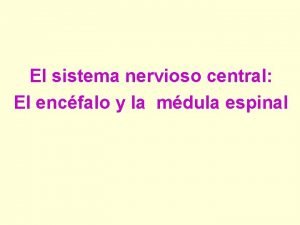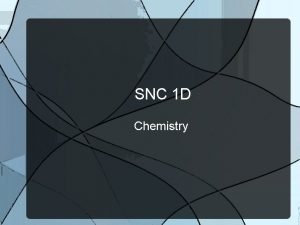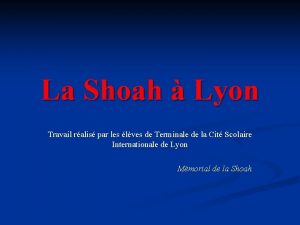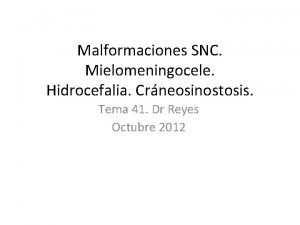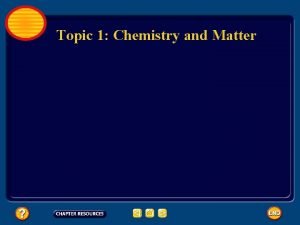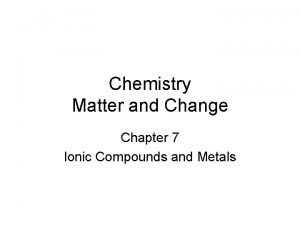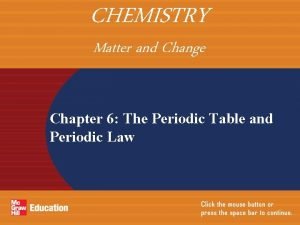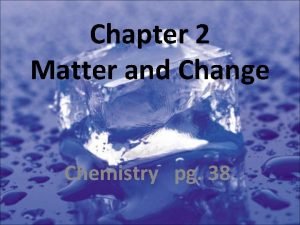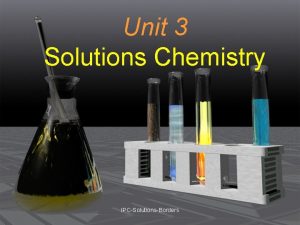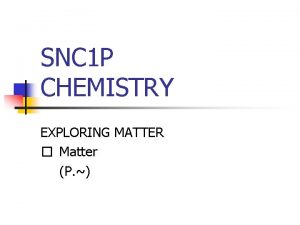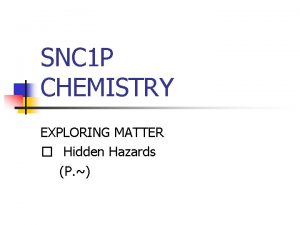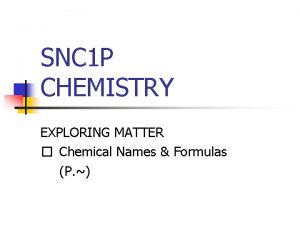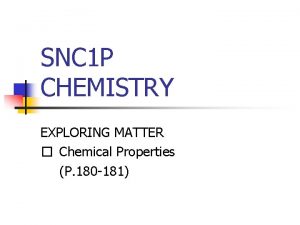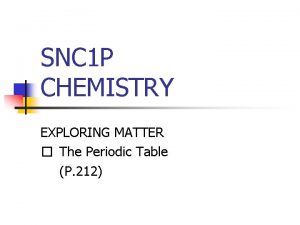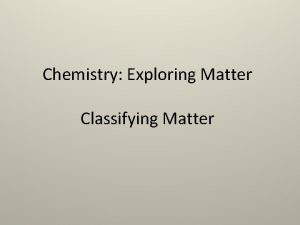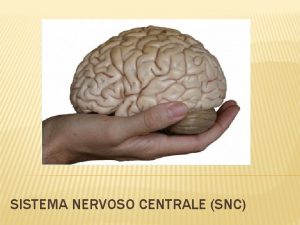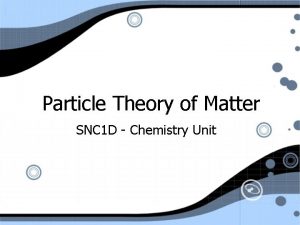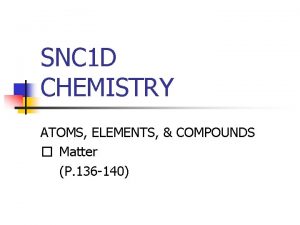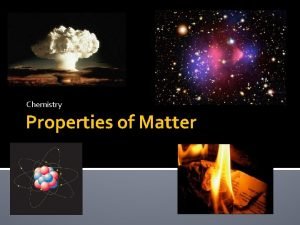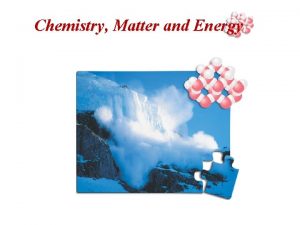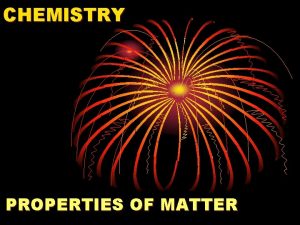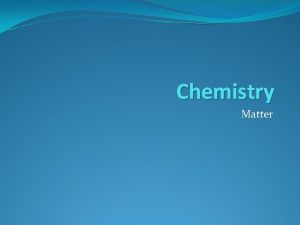SNC 1 P CHEMISTRY EXPLORING MATTER Patterns in






























- Slides: 30

SNC 1 P CHEMISTRY EXPLORING MATTER � Patterns in The Periodic Table (P. 213; P. 226 -227)

Patterns in The Periodic Table The periodic table is arranged in a particular way. All the elements in the same column have similar physical and chemical properties. If your classroom seating plan were organized in this way, everyone sitting in the same column would look similar and have similar personalities. Each student would still be an individual and different from all the other students. January 15, 2022 1 PCHEM - Patterns in The Periodic Table 1

Patterns in The Periodic Table However, if there were an empty seat, you would be able to guess the absent student's appearance and temperament. In this way, we can predict the properties of any element simply by its assigned location in the periodic table. That is the power of the periodic table for the elements. January 15, 2022 1 PCHEM - Patterns in The Periodic Table 2

Chemical Families When we compare the physical properties of elements within groups, a number of patterns become clear. Some groups have special names including: • alkali metals • alkaline earth metals • halogens • noble gases NOTE! It is the structure of the atom that helps explain why elements have similarities and differences. January 15, 2022 1 PCHEM - Patterns in The Periodic Table 3

Chemical Families The alkali metals (Group 1) consist of the elements below hydrogen in the first column of the periodic table, starting with lithium. These metals are all silver-grey in colour and like other metals, they are malleable and ductile, and they conduct electricity and heat. However, compared to other metals, the alkali metals have low melting points. They are all soft enough to cut with a knife. In addition, they all react violently with water (thus the reason they are stored in a non-reactive oil or kerosene). January 15, 2022 1 PCHEM - Patterns in The Periodic Table 4

Chemical Families ALKALI METALS (GROUP 1) v Li, Na, K, … v metals (shiny, silvery, malleable, . . . ) v react violently with water NOTE! There is a gradual change in the physical properties from the first element in this group to the last – their density increases, the elements get softer and easier to cut, and their reactivity with water increases. January 15, 2022 1 PCHEM - Patterns in The Periodic Table 5

Chemical Families The elements in Group 2 (beryllium, magnesium, calcium, …) are the alkaline earth metals. These metals are shiny and silvery but are not as soft or reactive as the alkali metals. As every growing child has been told, calcium (Ca) helps to build strong bones and teeth. Similarly, strontium (Sr) builds a strong shell in coral. Many substances composed of alkaline earth metals burn with bright, colourful flames. As a result of this property, alkaline earth metals such as magnesium are used in fireworks. January 15, 2022 1 PCHEM - Patterns in The Periodic Table 6

Chemical Families ALKALINE EARTH METALS (GROUP 2) v Be, Mg, Ca, … v metals (shiny, silvery, malleable, . . . ) v not as soft or reactive as alkali metals NOTE! In a similar fashion to the alkali metals there is a gradual change in the physical properties from the first element in this group to the last – density increases and reactivity increases. January 15, 2022 1 PCHEM - Patterns in The Periodic Table 7

Chemical Families The halogens in Group 17 are fluorine, chlorine, bromine, … All these elements are highly reactive. Fluorine reacts explosively with hydrogen to form hydrogen fluoride. Pure chlorine, bromine, and iodine are poisonous to living things. As such, they can be used as disinfectants. Another common use of these elements is in halogen lights. These lights are very bright, but also give off a great deal of thermal energy. This property makes them a potential fire hazard. January 15, 2022 1 PCHEM - Patterns in The Periodic Table 8

Chemical Families HALOGENS (GROUP 17) v F, Cl, Br, … v non-metals (dull, brittle, . . . ) v all are very reactive NOTE! From fluorine, the first element down through to iodine, the colours of the halogens grow in intensity. Their melting points also gradually increase from -219� C for fluorine to 113� C for iodine. January 15, 2022 1 PCHEM - Patterns in The Periodic Table 9

Chemical Families Unlike the halogens, the noble gases in Group 18 rarely react. But this does not mean they have no uses. Balloons filled with helium (He) rise because helium is less dense than air. Xenon (Xe) is used in the bluish high-intensity headlights of certain vehicles. All the noble gases give off brightly coloured light when electricity passes through them which makes them useful for decorative lights. January 15, 2022 1 PCHEM - Patterns in The Periodic Table 10

Chemical Families NOBLE GASES (GROUP 18) v He, Ne, Ar, … v non-metals v nonreactive or “inert” NOTE! The density of the gases increases steadily moving from helium through to radon. Balloons filled with helium will rise in air, while balloons filled with radon will sink quickly in air. January 15, 2022 1 PCHEM - Patterns in The Periodic Table 11

Chemical Families – DYK? The 38 elements in groups 3 through 12 of the periodic table are called transition metals. As with all metals, the transition elements are both ductile and malleable, and conduct electricity and heat. The interesting thing about transition metals is that their valence electrons, or the electrons they use to combine with other elements, are present in more than one shell. This is the reason why they often exhibit several common oxidation states. January 15, 2022 1 PCHEM - Patterns in The Periodic Table 12

Chemical Families – DYK? NOTE! There are three noteworthy elements in the transition metals family. These elements are iron, cobalt, and nickel, and they are the only elements known to produce a magnetic field. January 15, 2022 1 PCHEM - Patterns in The Periodic Table 13

Chemical Families & Reactivity? You have observed differences in the reactivity of the alkali metals with water. But why do these elements become more reactive as you descend a family in the periodic table? The Bohr-Rutherford model of the atom helps to explain this trend, as well as many other trends on the periodic table. January 15, 2022 1 PCHEM - Patterns in The Periodic Table 14

Bohr-Rutherford (B-R) Diagrams Atoms of all elements have the same basic atomic structure but contain different numbers of protons, neutrons, and electrons. A Bohr-Rutherford (B-R) diagram can be used to show the numbers and locations of protons, neutrons, and electrons in an atom. We can deduce these numbers from the atomic number and mass number: • the number of protons = the atomic number • the number neutrons = the difference between the mass number and the atomic number • the number of electrons = the number of protons in a neutral atom January 15, 2022 1 PCHEM - Patterns in The Periodic Table 15

Bohr-Rutherford (B-R) Diagrams PRACTICE 1. Draw a B-R diagram for the element nitrogen. January 15, 2022 1 PCHEM - Patterns in The Periodic Table 16

Bohr-Rutherford (B-R) Diagrams STEP 1 Determine the number of protons and the number of neutrons from the atomic number and the mass number (rounded to the nearest whole number. ) For nitrogen, the atomic number is 7 and the mass number is 14 (rounded). number of protons number of neutrons number of electrons January 15, 2022 = = = atomic number = 7 p+ mass number – atomic number 14 – 7 7 n 0 number of protons = 7 e- 1 PCHEM - Patterns in The Periodic Table 17

Bohr-Rutherford (B-R) Diagrams STEP 2 Draw a small circle for the nucleus. Write the number of protons and neutrons inside the nucleus. Because atoms are neutral in charge, the number of negatively charged electrons must equal the number of positively charged protons. Nitrogen has 7 protons (p+) and 7 neutrons (n 0). January 15, 2022 1 PCHEM - Patterns in The Periodic Table 18

Bohr-Rutherford (B-R) Diagrams STEP 3 Draw one to four concentric circles outside the nucleus to represent electron orbits. The number of circles depends on the number of electrons. Nitrogen has 7 electrons. The first orbit can hold a maximum of 2 electrons, so draw two circles. January 15, 2022 1 PCHEM - Patterns in The Periodic Table 19

Bohr-Rutherford (B-R) Diagrams STEP 4 Draw dots on these circles, starting with the circle immediately surrounding the nucleus, to represent the electrons in their orbits. Recall that there is a maximum number of electrons in each orbit! Nitrogen has 7 electrons. Draw a pair of dots in the first circle. Draw 5 dots in the second orbit. NOTE! Electrons are usually drawn equally spaced and are only paired up when there are more than 4 electrons in the 2 nd and 3 rd orbit. January 15, 2022 RECALL! The 1 st orbit can only hold 2 electrons while the 2 nd and 3 rd orbit can only hold 8 electrons. 1 PCHEM - Patterns in The Periodic Table 20

Activity: Bohr-Rutherford (B-R) Diagrams INSTRUCTIONS A. Complete 1 PCHEM - WS 3 (B-R Diagrams) QUESTIONS 1. What is the same about the electron arrangement of every element in a column (group)? What is different? 2. What is the same about the electron arrangement of every element in a row (period)? What is different? January 15, 2022 1 PCHEM - Patterns in The Periodic Table 21

Patterns in The Periodic Table Did you notice any pattern emerging from the periodic table of Bohr. Rutherford diagrams? Mendeleev would have been fascinated to see such a startling pattern from these “family portraits” of the elements. January 15, 2022 1 PCHEM - Patterns in The Periodic Table 22

Activity: Patterns in The Periodic Table QUESTIONS 1. Look at the diagram and describe the trend in the period number and the number of orbits. January 15, 2022 1 PCHEM - Patterns in The Periodic Table 23

Activity: Patterns in The Periodic Table QUESTIONS 2. Look at the diagram and describe the trend in the group number and the number of electrons in the outer orbit. Do you notice anything special about group 18? January 15, 2022 1 PCHEM - Patterns in The Periodic Table 24

Patterns in The Periodic Table – Reactivity NOTE! It is this electron arrangement that helps explain why the reaction of the alkali metals with water becomes more vigorous as you go down the group. It also helps to explain why the noble gases are non-reactive. January 15, 2022 1 PCHEM - Patterns in The Periodic Table 25

Patterns in The Periodic Table – Reactivity Evidence suggests that when an alkali metal reacts with water, the alkali metal atoms lose one electron. The most likely electron to be lost is the single electron in the outermost orbit. This electron is farthest from the nucleus, so it has the weakest attraction to the nucleus. Furthermore, since the outermost electron of the sodium atom is farther from the nucleus than the outermost electron of the lithium atom, sodium reacts faster with water than lithium does. So, the reactivity of the alkali metals increase as you do down Group 1. The same is true for the alkaline earth metals (i. e. elements in group 2) and the halogens (i. e. elements in group 17). January 15, 2022 1 PCHEM - Patterns in The Periodic Table 26

Patterns in The Periodic Table – Reactivity Conversely, the noble gases (i. e. group 18) are stable and non-reactive since their outermost orbit is full. In other words, they do not lose or gain any electrons. January 15, 2022 1 PCHEM - Patterns in The Periodic Table 27

Patterns in The Periodic Table PATTERNS IN THE PERIODIC TABLE v as you go down each chemical family: • the atomic number and mass increases • the number of orbits increases • the density increases • the reactivity (groups 1, 2 and 17) increases v within each family, all the atoms have the same number of electrons in their outermost orbits v the noble gases (group 18) are non-reactive because their outermost orbit is full v elements that do not have the maximum number of electrons in their outermost orbits combine with other elements to obtain this maximum number of electrons (groups 1 -17) January 15, 2022 1 PCHEM - Patterns in The Periodic Table 28

�Check Your Learning WIKI (CHEMISTRY) �. . 1 PCHEM - QUIZ 2 (The Periodic Table) REMEMBER! Be sure to check, correct, and total your quiz before handing it in. January 15, 2022 1 PCHEM - Patterns in The Periodic Table 29
 Skeleton hand whmis
Skeleton hand whmis Sistema nervioso central
Sistema nervioso central Water density
Water density Snc lajaa venissieux
Snc lajaa venissieux Snc
Snc Síndrome de pfeiffer tipo 2
Síndrome de pfeiffer tipo 2 Snc database
Snc database Classification of matter section 1 composition of matter
Classification of matter section 1 composition of matter What is the difference between gray and grey
What is the difference between gray and grey Composition of matter section 1
Composition of matter section 1 Chapter 2 section 1 classifying matter answer key
Chapter 2 section 1 classifying matter answer key Arbor vitae
Arbor vitae Composition of matter section 1
Composition of matter section 1 Gray matter and white matter
Gray matter and white matter Gray matter
Gray matter Flow energy review
Flow energy review In traditional dating patterns dating behavior
In traditional dating patterns dating behavior Mining frequent patterns associations and correlations
Mining frequent patterns associations and correlations Chemistry matter and its changes
Chemistry matter and its changes Chemistry matter and change chapter 7
Chemistry matter and change chapter 7 Chapter 10 chemistry study guide
Chapter 10 chemistry study guide Examples of matter in chemistry
Examples of matter in chemistry What is a matter flow chart
What is a matter flow chart 1s 22 s22 p63 s23 p64 s2
1s 22 s22 p63 s23 p64 s2 Chemistry matter and change chapter 6
Chemistry matter and change chapter 6 Chemistry matter and change chapter 10 the mole answer key
Chemistry matter and change chapter 10 the mole answer key Chemistry matter and change chapter 2 answer key
Chemistry matter and change chapter 2 answer key Flowchart undissolved solids
Flowchart undissolved solids Classification graphic organizer examples
Classification graphic organizer examples Non examples of homogeneous mixture
Non examples of homogeneous mixture Chapter 4 basic food chemistry the nature of matter
Chapter 4 basic food chemistry the nature of matter

